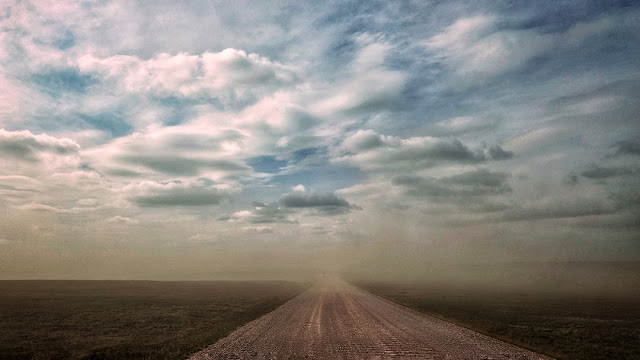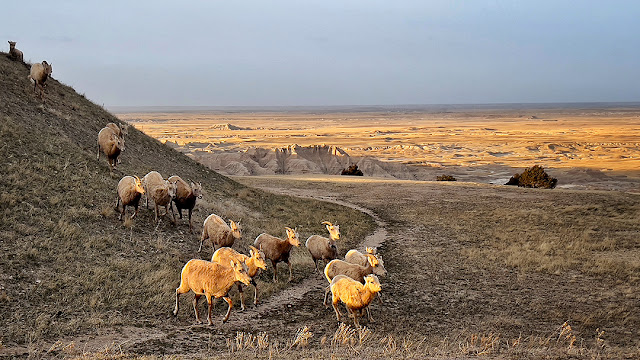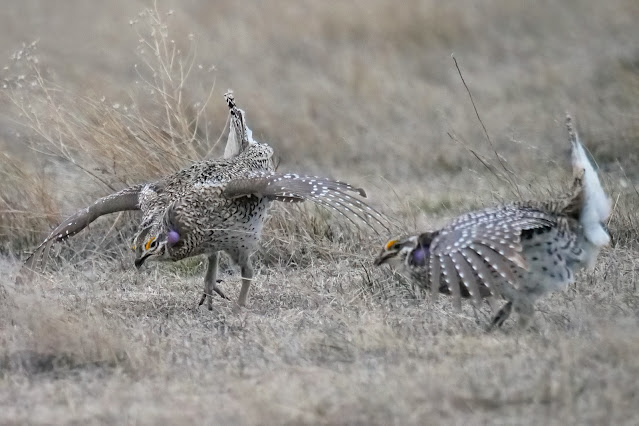Weather and Best Made Plans
Christine and I thought we would have a solid day of sharp-tailed grouse photography behind us and ready to share images. But with temperatures in the mid teens and wind chill factor at near -3 degrees, we thought better of visiting the blind this morning. Yes, we "chickened" out.
Wind whipped up large particles of dust and flying debris so powerful it was almost impossible to open a car door or a window to photograph from. Smartphones were our friend today. A couple minutes outside the vehicle and you felt your bones begin to freeze, the grit in your teeth and foreign particles in your eyes.
The chances we were going to find any animal out and about, including grouse on a lek, was unlikely. So we made the decision to sleep in and wait until the weather improved. Tomorrows forecast is no different but we have two more days in South Dakota and two more chances at photographing the "sharpies" (sharp-tailed grouse) we came for.
Further disappointing news came from Montana. Hazardous conditions makes it impossible for us to visit leks in big sky country this year. 30+ inches of snow and wind gusts of 40 knots keeps us in South Dakota for the time being. Best made plans strike again.
But the weather did not stop us! While traveling the plains we were rewarded with striking images of large ungulates who, in addition to grouse, also make prairies their home and whose coat can withstand the foul weather we are experiencing.
How did courageous pioneers ever cross these wind-sweep plains?
Today turned out to be special despite high winds. Prairies are amazing! We are surrounded by native grasslands as far as you could see and several opportunities to photograph iconic animals of the Great Plains.
A little about prairies ...
Only about 1% of original grasslands remain in the United States. Once grasslands have been destroyed it can take decades or even centuries to restore them. Most are now scattered in relatively small tracts, can contain anywhere from 40 to 60 different grass species and considered one of the rarest and most endangered ecosystems the world. Grasslands store tons of carbon in their soils, prevent erosion and stabilize the soil.
Prairies host an enormous bird diversity including many grouse species and are home to pollinators like bees and monarch butterflies. Some prairies contain as many as 300 species of flowering plants. Bison, elk, black bears and wolves once roamed these lands, along with smaller mammals such as badgers, coyotes, gophers, ground squirrels and voles. And don't forget the reptiles and insects too.
Prairies can still be found in the Midwest states of North Dakota, South Dakota, Montana, Nebraska, Kansas, Oklahoma, Texas, Wyoming, Colorado, and New Mexico.
Threats to prairies include loss of habitat from agriculture development, oil and gas expansion, invasive species such as cheatgrass, encroaching red cedars, vertical structures including transmission and power lines, urban sprawl, pesticides, climate change and neglect.
Our grasslands are worth saving. A healthy prairie captures carbon, supports pollinators, harbors plant species and so much more. Learn more about prairies HERE.
And don't forget to follow our posts and learn along with us here at Chicks on a Grouse Trip! Thanks.







Wow, 78 degrees in NJ. Stay warm you two !!
ReplyDeleteJulie
The wind is what is making things so difficult. Of course, cold is not ideal for us Southern California girls, but we have the clothes for it. Yesterday we were in several gusts of sand that stopped us in our tracks before we could move along in the Badlands. It was a beautiful day for photos thought....often from the car to protect us from the wind and sand.
DeleteHope you have better conditions in the days ahead. Time is here to wade through the snow and feed the critters.
ReplyDeleteWishing you the same Marshall! We had excellent viewing this morning with winds only 11 mph on the lek. Watch for the next post!
Delete